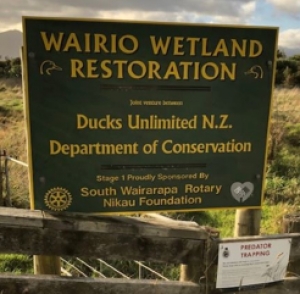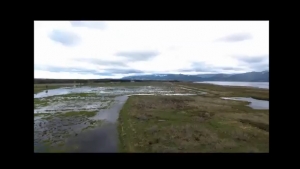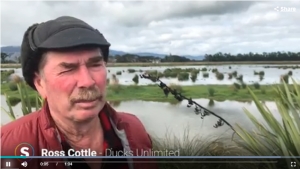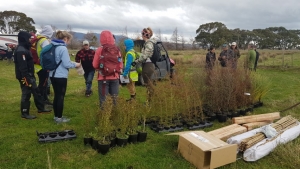Displaying items by tag: Wairarapa Moana
2022 Wairarapa Moana annual spring matuku and spotless crake survey
First recorded booming within the DU Wairio wetland
The spring 2022 survey report compiled by Shane Cotter, a contractor engaged by GWRC.
John Cheyne of Wetlands Works led annual spring surveys for Australasian bittern (matuku, Botaurus poiciloptilus) and spotless crake (pūweto, Zapornia tabuensis) at selected wetlands within Wairarapa Moana between 2012 and 2021. In 2022, John passed this responsibility to me. I conducted the annual spring (October-November) 2022 survey using the same methodology as in previous years so continued comparisons could be made of the annual results.
This year’s survey focused on the core wetlands (Boggy Pond, Matthew’s Lagoon and Wairio wetland) and the northern wetlands (Barton’s Lagoon, Tauherenikau delta, Simmond’s Lagoon, JK Donald Block). Only booming male matuku are surveyed because females are much less vocal and therefore very difficult to detect and monitor. This booming call is associated with males attempting to attract females for breeding. Pūweto were also surveyed at Boggy Pond and Matthew’s Lagoon.
In the 2022 survey, 11 booming male matuku were located at the core wetlands and 12 in the northern wetlands. This is an increase in previous years and a record number at both locations. At the core wetlands, numbers have remained relatively stable at 8-9 birds since 2014 while at the northern wetlands, annual numbers of male matuku has varied between 3-9 birds. Overall, the combined number of booming male matuku at the core and northern wetlands has steadily increased from 10 in 2016, to 16 in 2018, to 18 in 2020, and now 23 birds in 2022. In addition to the 23 male matuku heard booming during the 2022 survey, three other birds were seen, one in Matthew’s Lagoon near Boggy Pond and two in Wairio wetland.
At Boggy Pond, nine pūweto were located, the most in Boggy Pond since 2018 and significantly up on the single individual in 2021. At Matthew’s Lagoon, none were recorded during the kayak survey which has been a regular result there since 2014. While undertaking the matuku survey, four other pūweto were heard calling independently, not in response to playback calls. Two were calling in Matthew’s Lagoon close to each other while at two locations within Wairio wetland, one individual was heard calling. I believe there are more pūweto present than recorded during the pūweto surveys. They have just moved to different areas of the wetland complex outside the pūweto survey routes seeking more suitable habitat.
On-going predator trapping with the regular servicing of traps is essential as several predators were seen dead in traps within days of the traps being serviced and rebaited with fresh bait by the trapping contractor at the core wetlands. These included a weasel and several rats. All traps observed were well set up and maintained, and had good vegetation clearance.
Follow the 'read more' link to view the survey report.
Wairio Wetlands Guided walk-through
Sunday 9 May 2021 at 12.30pm
Rural Women NZ Martinborough invite you to join them on a guided walk through
the Wairio Wetlands on the eastern shore of Lake Wairarapa.
4.2 km one-way, round trip 7 km. Return transport provided if required.
Witness the 15 year restoration programme led by Ducks Unlimited NZ.
Good walking track, sensible footwear required but unfortunately not suitable for wheelchairs.
No toilet facilities available. No dogs allowed. Will go ahead rain or shine.
Directions: From Kahutara Road turn on to Parera Road and continue for approximately 2.6 km.
The gathering point will be clearly indicated.
Cost is $5.00 per person, with all funds to support Associated Country Women of the World,
to assist with community projects in developing countries.
Contact: Marilyn Law 027 2239354 or Viv Malneek 027 5358805 if further information required.

Wetlands to protect
Wetland importance is often under-rated. Groups like our own DU, Wetland Care and the National Wetlands Trust are working towards reversing this trend.
There is a great diversity of wildlife in our wetlands with more native birds, fish,
invertebrates and plants than most other habitats, yet many wetland species are threatened with extinction. Wetlands have high recreational values, and perform vital ecosystem services such as improving water quality and reducing flood risks.
They have a big role in managing climate change. Healthy peat bogs are year-round sinks of 2-5 tonnes of carbon per hectare – locking it up in their soil indefinitely.
Wetlands are of cultural and spiritual significance to Maori. They provided Maori with food (wildfowl, eels and other freshwater fish), taro cultivation, harakeke (flax) for weaving and other materials for medicinal, food, building, and craft use.
A plethora of wetland to visit
Managed by DOC, the 5923ha of peat bog, swampland, mesotrophic lags, open water and river systems, is an important habitat for threatened species like Australasian bittern, grey teal, spotless crake, the North Island fernbird and black mudfish.
Firth of Thames
At the base of Coromandel Peninsula, the Firth of Thames has 8500ha of wide inter-tidal flats which attract thousands of migratory wading birds. Some make the arduous 10,000km journey south from the Arctic in spring and fly north again in the autumn; others fly 1000km north from the braided rivers of the South Island in the autumn and return in the spring.
Wairarapa Moana Wetlands Park
Lake Wairarapa, Lake Onoke and their associated wetlands make up the largest
wetland complex in the southern North Island, supporting native plants and animals of national and international importance.
The diverse habitats within Wairarapa Moana attract a wide range of wetland birds - about 100 species including international migratory birds.
Lower Kaituna Wildlife Reserve
Northeast of Te Puke, western Bay of Plenty, Kaituna is a reminder of how the country used to be with an abundance of cabbage trees and flax, pukeko prowling through raupo, numerous ducks, shags and pied stilts foraging for food in the waterways.
West Coast wetlands
The South Island’s West Coast has a variety of large and valuable wetlands, including lakes, swamps, fens, bogs, marshes, lagoons,
Ō Tū Wharekai wetland
Ō Tū Wharekai, covering the Ashburton lakes and Upper Rangitata River in Canterbury, is an unspoiled, intact, intermontane wetland system and is nationally important for wildlife.
Otago wetlands
Lake Waipori, Lake Waihola and their associated wetlands are the most significant waterfowl habitat in Otago 40km south of Dunedin. The lakes are shallow and drain through an extensive swamp into the Waipori River and then the Taieri River.
Over 60 species of bird live in or visit the wetland. It is now privately owned by Te Rūnanga o Ngāi Tahu and protected by a QE II National Trust Open Space Covenant.
More than 80 bird species have been sighted in the area, 65 of which are dependent on the estuarine environment.
Southland’s estuaries rank alongside Farewell Spit and Lake Ellesmere as the top three wading bird habitats in the South Island.
Wairio Wetland Drone Tour
Drone Tour of the Wairio wetlands
Watch the Drone Tour of the wetlands that was created by the Victoria University Research team
Drone view flying over the Wairio Complex
Video interview
DU President - Video Interview
Well-known journalist, Piers Fuller, interviews DUNZ President Ross Cottle about the history of the celebrated Wairio Wetland development
You can view the video interview here
Classroom in a Wetland
Victoria University’s classroom in a wetland!
Five years ago, Victoria University Wellington students planted a swathe of nursery trees in the Wairio Wetland.
This landmark wetland habitat was created in the late 1980s by Ducks Unlimited in Collaboration with the Department of Conservation (DOC).
Last week the Victoria University biodiversity team were back. Stephen Hartley and his team were armed with over 300 specimen trees (Kahikatea, Totara, Tawaki (or Swamp) Maire & Cabbage)- sourced thanks to a $2000 grant from DOC - to continue their comparative research into cost effective restoration processes by adding these trees as infill planting.
The cold but enthusiastic University team were supported by members of Ducks Unlimited and DOC.





